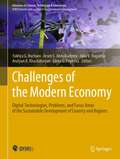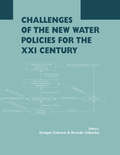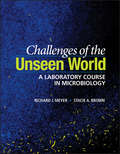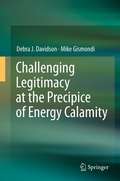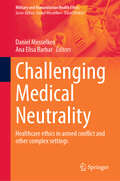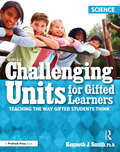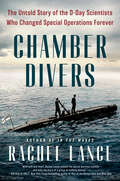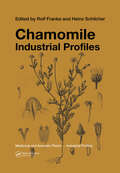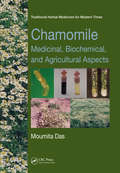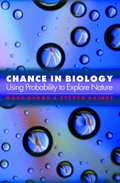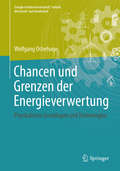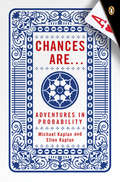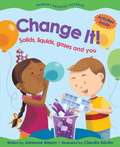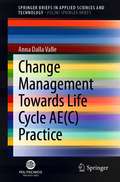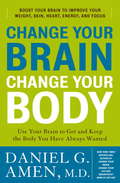- Table View
- List View
Challenges of the Modern Economy: Digital Technologies, Problems, and Focus Areas of the Sustainable Development of Country and Regions (Advances in Science, Technology & Innovation)
by Elena G. Popkova Julia V. Ragulina Yakhya G. Buchaev Arsen S. Abdulkadyrov Arutyun A. KhachaturyanThe book focuses on a systemic study of the challenges of the modern economy and related problems and areas of sustainable development of countries, regions, and businesses, with particular attention paid to the new prospects offered by the spread of digital technology. The book’s contribution to the literature is that it reveals the specifics and digital perspectives of supporting the SDGs in the economy at every level of the economy: country, regional, and corporate, considering sectoral specificities—this is reflected in six parts of the book. Part 1 identifies contemporary challenges of the modern economy as barriers to sustainable development. Part 2 reflects the future direction of sustainable development of the countries. Part 3 considers the problems and prospects for sustainable development of regions. Part 4 focuses on the problems and prospects for the sustainable development of enterprises and industries. Part 5 sheds light on the economic and legal foundations and cooperative mechanisms of sustainable development. Part 6 offers recommendations for enhancing the use of digital technologies offered by Industry 4.0 to support the SDGs. Scientists whose research interests include sustainable economic development are the primary target audience for this book. For the primary target audience, the book forms a systemic view of the global challenges of sustainable development and offers a set of scientific and methodological recommendations to provide an effective response to these challenges at every level of the economy. An additional audience for the book is practicing experts, who will find international best practices and applied recommendations to support sustainable economic development and implementation of the SDGs in the practice of state (national regulation and public administration of the region) and corporate (in various industries) management.
Challenges of the New Water Policies for the XXI Century: Proceedings of the Seminar on Challenges of the New Water Policies for the 21st Century, Valencia, 29-31 October 2002
by Enrique Cabrera Ricardo CobachoThe concept of sustainable development appeared almost twenty years ago, adapting traditional policies to new circumstances, and promoting progress capable of satisfying the necessities of both present and future generations. It is widely believed that the need for a proper and sustainable management of water will be a problem which
Challenges of the Technological Mind: Between Philosophy and Technology (New Directions in Philosophy and Cognitive Science)
by Paulo Alexandre e CastroThis book presents a set of texts that reflect different approaches to the relationship between mind and technology. In today’s increasingly technological world, a myriad of different and dizzying challenges face humanity: the ever-closer relationship between man and machine, the exponential development of Artificial Intelligence, man's relationship with virtual worlds, the relationship with new realities such as the neuro potentiation of his capacities, the appearance of robots in everyday life, and so on. In this volume, renowned world specialists explore these concerns, and discuss limitations and possible problems surrounding the interaction of man and machine. The book provides a well-researched, thought-provoking analysis of the need to rethink the theory of the mind, proposing relevant answers to pressing questions and raising new questions that need to be considered.
Challenges of the Unseen World: A Laboratory Course in Microbiology (ASM Books)
by Richard Meyer Stacie BrownSolving real-world health challenges in a learning environment You are at an exciting gateway into the world of microorganisms. With nothing more than basic lab equipment such as microscopes, Petri dishes, media, and a handful of reagents, you will learn to isolate, grow, and identify bacteria that live all around us. This is no ordinary microbiology laboratory course; not only will you learn how to streak plates, use a microscope, perform a Gram stain, and prepare serial dilutions and spread plates—fundamental skills found in every microbiologist's toolkit—you will solve a series of public health–related challenges that many professional microbiologists encounter in their work. By the end of this course, you will: Determine the origin of a nosocomial infection. Using foundational and molecular methods, you will determine whether the infections occurring in hospitalized patients are the result of contaminated medical items. Select the antibiotic to treat a patient with Crohn's disease. You will find minimum inhibitory concentrations of various antibiotics for a Pseudomonas strain associated with Crohn's disease. Pinpoint the source of lettuce contaminated with E. coli. Using molecular tools you will investigate a common food safety challenge, antibiotic-resistant E. coli and the potential for spread of this resistance in the environment. Find the farm releasing pathogens into a stream used for drinking water. Using bacteriophage load in water samples, you will locate the source of fecal contamination in the water supply of a village in an underdeveloped country. Evaluate the potential of bacteria to cause a urinary tract infection. You will test for biofilms, quorum sensing behavior, and chemotaxis and assess which disinfectants would be most effective for sanitizing contaminated surfaces. Microbiology educators and researchers Richard Meyer and Stacie Brown have created this hands-on, engaging introduction to the essential laboratory skills in the microbial sciences that is sure to change the way you view the world around you.
Challenging Cases in Paediatric Radiology
by Manda Raz Asthik Biswas Farha Furruqh Michael DitchfieldThe book covers challenging clinical radiological cases spanning the central nervous system, respiratory and cardiovascular systems, gastrointestinal system, genitourinary system, musculoskeletal system, as well as multi-organ cases in paediatric patients. Each case includes pathognomonic images followed by a quiz to test the reader and a discussion of the case with a focus on key diagnostic features to help the reader recognise the case in working and examination environments. It combines the expertise of radiology consultants and trainees in order to provide pertinent information conducive to better clinical practice and focused specialty exam preparation in paediatric radiology
Challenging Legitimacy at the Precipice of Energy Calamity
by Mike Gismondi Debra J. DavidsonHuman history has often been described as a progressive relinquishment from environmental constraints. Now, it seems, we have come full circle. The ecological irrationalities associated with industrial societies have a lengthy history, and our purpose in the proposed book is not to catalogue this litany of wrongs. Rather, this book is about political responses to global environmental crisis at a crucial turning point in history, by focusing on the political discourses surrounding the tar sands in Alberta, Canada.
Challenging Medical Neutrality: Healthcare ethics in armed conflict and other complex settings (Military and Humanitarian Health Ethics)
by Daniel Messelken Ana Elisa BarbarIn this volume, the concept of "medical neutrality," which states that medical services should not be interfered with during armed conflicts and other emergencies, is challenged based on the experience and expertise of the authors, who come from diverse military, humanitarian, and academic backgrounds. The principle of medical neutrality is grounded in International Humanitarian Law as well as in Human Rights Law and it can be justified by ethical rationales such as the principle of Humanity and ordinary medical ethics. Health workers often understand medical neutrality as an obligation not to engage in anything else other than medical outcomes. In this book, a variety of problems and ethical issues in the application of medical neutrality in the professional practice of healthcare personnel are analyzed. The contributors expand the debate around “medical neutrality” and aim at better-informing policy and operational decisions regarding the application of medical ethics, the protection of medical missions in conflict, and the training of healthcare professionals to operate ethically and safely in volatile environments. The volume is of great interest to academics, practitioners, policymakers, and students who are looking for analyses and guidance regarding medical neutrality.
Challenging Popular Myths of Sex, Gender and Biology (Crossroads of Knowledge #1)
by Malin Ah-KingThis edited volume challenges popular notions of sex, gender and biology and features international, trans-disciplinary research. The book begins with an exploration of supposedly 'natural' sexual differences, then looks at research in evolutionary biology and examines topics such as gender stereotypes in humans. The first chapters explore important questions: What are the fundamental sex differences? How do genes and hormones influence an individual's sex? Subsequent chapters concern topics including: sex stereotypes in the field of sexual conflict, how the focus on genes in evolutionary biology disregards other means of inheritance, and the development of Darwin's theory of sex differences. The last three chapters look at humans, discussing: an interdisciplinary approach to the evolution of sex differences in body height, biological versus social constructive perspectives on the gendering of voices and nature-culture arguments in the current political debate on paternity leave in Norway.
Challenging Units for Gifted Learners: Teaching the Way Gifted Students Think (Science, Grades 6-8)
by Kenneth J. SmithGifted students have the potential to learn material earlier and faster, to handle more abstraction, and to solve complex problems better. This potential, however, needs stimulating experiences from home and school or it will not unfold. These books are designed to help teachers provide the engaging curricula that will nurture this potential in school. The Science book includes a medical simulation in which teams of students work as doctors to diagnose patients' cases, a food science project in which students use a variety of information-gathering techniques to learn how nutrition impacts performance, a hands-on study of human memory and expertise, and a study of the physics of sports.Grades 6-8
Chamber Divers: The Untold Story of the D-Day Scientists Who Changed Special Operations Forever
by Rachel LanceThe previously classified story of the eccentric researchers who invented cutting-edge underwater science to lead the Allies to D-Day victoryIn August 1942, more than 7,000 Allied troops rushed the beaches of Normandy, France, in an all but-forgotten landing. Only a small fraction survived unscathed. It was two summers before D-Day, and the Allies realized that they were in dire need of underwater intelligence if they wanted to stand a chance of launching another beach invasion and of winning the war.Led by the controversial biologists J. B. S. Haldane and Dr. Helen Spurway, an ingenious team of ragtag scientists worked out of homemade labs during the London Blitz. Beneath a rain of bombs, they pioneered thrilling advances in underwater reconnaissance through tests done on themselves in painful and potentially fatal experiments. Their discoveries led to the safe use of miniature submarines and breathing apparatuses, which ultimately let the Allies take the beaches of Normandy.Blast injury specialist Dr. Rachel Lance unpacks the harrowing narratives of these experiments while bringing to life the men and women whose brilliance and self-sacrifice shaped the outcome of the war, including their personal relationships with one another and the ways they faced skepticism and danger in their quest to enable Allied troops to breathe underwater.The riveting science leading up to D-Day has been classified for generations, but Chamber Divers finally brings these scientists&’ stories—and their heroism—to light.
Chamomile: Industrial Profiles
by Rolf Franke Heinz SchilcherFor over 2000 years, preparations of chamomile flowers have counted among the medicinal treasures of many cultural groups. This book provides an interdisciplinary inventory of the scientific level of knowledge about German chamomile as well as Roman chamomile, the two types of chamomile most produced. It includes information for pharmacists and the
Chamomile: Medicinal, Biochemical, and Agricultural Aspects (Traditional Herbal Medicines for Modern Times)
by Moumita DasIn use as a medicinal plant since time immemorial in Europe and the Middle East, chamomile is gaining popularity in the Americas, Australia, and Asia. The spectrum of disease conditions in which it is used in traditional medicine systems is, quite simply, mind boggling. There is, without a doubt, a growing demand for this plant and therefore a grow
Chance in Biology: Using Probability to Explore Nature
by Steven Gaines Mark DennyLife is a chancy proposition: from the movement of molecules to the age at which we die, chance plays a key role in the natural world. Traditionally, biologists have viewed the inevitable "noise" of life as an unfortunate complication. The authors of this book, however, treat random processes as a benefit. In this introduction to chance in biology, Mark Denny and Steven Gaines help readers to apply the probability theory needed to make sense of chance events--using examples from ocean waves to spiderwebs, in fields ranging from molecular mechanics to evolution. Through the application of probability theory, Denny and Gaines make predictions about how plants and animals work in a stochastic universe. Is it possible to pack a variety of ion channels into a cell membrane and have each operate at near-peak flow? Why are our arteries rubbery? The concept of a random walk provides the necessary insight. Is there an absolute upper limit to human life span? Could the sound of a cocktail party burst your eardrums? The statistics of extremes allows us to make the appropriate calculations. How long must you wait to see the detail in a moonlit landscape? Can you hear the noise of individual molecules? The authors provide answers to these and many other questions. After an introduction to the basic statistical methods to be used in this book, the authors emphasize the application of probability theory to biology rather than the details of the theory itself. Readers with an introductory background in calculus will be able to follow the reasoning, and sets of problems, together with their solutions, are offered to reinforce concepts. The use of real-world examples, numerous illustrations, and chapter summaries--all presented with clarity and wit--make for a highly accessible text. By relating the theory of probability to the understanding of form and function in living things, the authors seek to pique the reader's curiosity about statistics and provide a new perspective on the role of chance in biology.
Chance in Evolution
by Charles H. Pence Grant RamseyHumans, however much we would care to think otherwise, do not represent the fated pinnacle of ape evolution. The diversity of life, from single-celled organisms to multicellular animals and plants, is the result of a long, complex, and highly chancy history. But how profoundly has chance shaped life on earth? And what, precisely, do we mean by chance? Bringing together biologists, philosophers of science, and historians of science, Chance in Evolution is the first book to untangle the far-reaching effects of chance, contingency, and randomness on the evolution of life. The book begins by placing chance in historical context, starting with the ancients and moving through Darwin and his contemporaries, documenting how the understanding of chance changed as Darwin's theory of evolution by natural selection developed into the modern synthesis, and how the acceptance of chance in Darwinian theory affected theological resistance to it. Subsequent chapters detail the role of chance in contemporary evolutionary theory--in particular, in connection with the concepts of genetic drift, mutation, and parallel evolution--as well as recent empirical work in the experimental evolution of microbes and in paleobiology. By engaging in collaboration across biology, history, philosophy, and theology, this book offers a comprehensive and synthetic overview both of the history of chance in evolution and of our current best understanding of the impact of chance on life on earth.
Chance: The science and secrets of luck, randomness and probability (New Scientist Ser.)
by New ScientistFor you to be here today reading this requires a mind-boggling series of lucky breaks, starting with the Big Bang and ending in your own conception. So it's not surprising that we persist in thinking that we're in with a chance, whether we're playing the lottery or working out the likelihood of extra-terrestrial life. In Chance, a (not entirely) random selection of the New Scientist's sharpest minds provide fascinating insights into luck, randomness, risk and probability. From the secrets of coincidence to placing the perfect bet, the science of random number generation to the surprisingly haphazard decisions of criminal juries, it explores these and many other tantalising questions.Following on from the bestselling Nothing and Question Everything, this book will open your eyes to the weird and wonderful world of chance - and help you see when some things, in fact, aren't random at all.
Chancen einer nachhaltigen IT: Wege zu einer ressourceneffizienten Softwareentwicklung
by Gerhard Wanner Konrad Pfeilsticker Daniel SonnetDas Buch adressiert die zwei Themen Erstellung ressourceneffizienter Software sowie den ressourceneffizienten Betrieb von Software. Für die Mehrheit aller Unternehmen in Deutschland sind bei der Entwicklung von Software die Dimensionen „in budget“, „in time“ und „in function“ wichtig. Die Dimension „in climate“ gewinnt vor dem Hintergrund der Klima- und der Energiekrise stark an Bedeutung. Dabei muss die Dimension „in climate“ nicht im Kontrast zu den anderen Dimensionen stehen. Bei näherer Betrachtung kann sie sogar die anderen Dimensionen ergänzen. In Bezug auf den Betrieb von IT-Systemen liegt aktuell der Fokus bei den deutschen Firmen auf Performance und Verfügbarkeit. Einbußen in diesen beiden Bereichen wird oftmals mit einem Mehr an Infrastruktur begegnet, welches höheren Ressourcenverbrauch bedeutet und damit ggf. höhere CO2-Emissionen impliziert. Dabei müssen Performance und Verfügbarkeit nicht im Widerspruch zu moderaten CO2-Emissionen stehen. Dieses Buch stellt zunächst die Ergebnisse einer Umfrage unter Entscheiderinnen und Entscheidern zum Thema Green-IT dar, mit Fragen zu einer nachhaltigen IT in Bezug auf die Entwicklung und den Betrieb von Software. Aufbauend auf der Umfrage werden konkrete Maßnahmen zur Reduktion von CO2 beim Entwurf und beim Bau von Software dargestellt sowie Möglichkeiten eines energieeffizienten Betriebs im eigenen Rechenzentrum und in der Cloud aufgezeigt. Neben einem ausführlichen Theorieteil bietet das Buch mehrere Best-Practice-Beispiele und eine illustrative Fallstudie.
Chancen und Grenzen der Energieverwertung: Physikalische Grundlagen und Technologien (Energie in Naturwissenschaft, Technik, Wirtschaft und Gesellschaft)
by Wolfgang OsterhageIn diesem Band ist ein Gesamt-Überblick über den State-of-the-Art der Energiediskussion, eine Komplettdarstellung aller Technologien und deren physikalische Grundlagen für Praktiker und interessierte Leser mit Grundkenntnissen gegeben. Der erste Teil bietet eine Basis für alle Lesergruppen. Als Grundlagen der Energieverwertung werden Energiebilanzen, die durch die Hauptsätze der Thermodynamik bestimmt werden, atom- und kernphysikalische Vorgänge, sowie die Gesetze der Strömungsmechanik und des Elektromagnetismus vorgestellt. Die daraus resultierenden Technologien wie Dampfkraftanlagen, Solar- und Windenergie, Wasserkraft, Biomasse und Erdwärme werden erörtert. Schließlich erfolgt ein Ausblick auf zukunftsweisende Projekte wie Kernfusion, Brennstoffzelle. Smart-Energy-Konzepte, Geschäftsmodelle und Aspekte der Datensicherheit sind ebenfalls besprochen. Auf die Rolle von Energiebilanzen beim Climate Engineering wird abschließend eingegangen.
Chances Are
by Michael Kaplan Ellen KaplanA compelling journey through history, mathematics, and philosophy, charting humanity's struggle against randomness Our lives are played out in the arena of chance. However little we recognize it in our day-to-day existence, we are always riding the odds, seeking out certainty but settling--reluctantly--for likelihood, building our beliefs on the shadowy props of probability. Chances Are is the story of man's millennia-long search for the tools to manage the recurrent but unpredictable--to help us prevent, or at least mitigate, the seemingly random blows of disaster, disease, and injustice. In these pages, we meet the brilliant individuals who developed the first abstract formulations of probability, as well as the intrepid visionaries who recognized their practical applications--from gamblers to military strategists to meteorologists to medical researchers, from blackjack to our own mortality.
Chancing It: The Laws of Chance and How They Can Work for You
by Robert MatthewsMake your own luck by understanding probabilityOver the years, some very smart people have thought they understood the rules of chance?only to fail dismally. Whether you call it probability, risk, or uncertainty, the workings of chance often defy common sense. Fortunately, advances in math and science have revealed the laws of chance, and understanding those laws can help in your everyday life.In Chancing It, award-winning scientist and writer Robert Matthews shows how to understand the laws of probability and use them to your advantage. He gives you access to some of the most potent intellectual tools ever developed and explains how to use them to guide your judgments and decisions. By the end of the book, you will know:How to understand and even predict coincidencesWhen an insurance policy is worth havingWhy “expert” predictions are often misleadingHow to tell when a scientific claim is a breakthrough or baloneyWhen it makes sense to place a bet on anything from sports to stock marketsA groundbreaking introduction to the power of probability, Chancing It will sharpen your decision-making and maximize your luck.
Chandra's Cosmos: Dark Matter, Black Holes, and Other Wonders Revealed by NASA's Premier X-Ray Observatory
by Wallace H. TuckerOn July 23, 1999, the Chandra X-Ray Observatory, the most powerful X-ray telescope ever built, was launched aboard the space shuttle Columbia. Since then, Chandra has given us a view of the universe that is largely hidden from telescopes sensitive only to visible light. In Chandra's Cosmos, the Smithsonian Astrophysical Observatory's Chandra science spokesperson Wallace H. Tucker uses a series of short, connected stories to describe the telescope's exploration of the hot, high-energy face of the universe. The book is organized in three parts: "The Big," covering the cosmic web, dark energy, dark matter, and massive clusters of galaxies; "The Bad," exploring neutron stars, stellar black holes, and supermassive black holes; and "The Beautiful," discussing stars, exoplanets, and life.Chandra has imaged the spectacular, glowing remains of exploded stars and taken spectra showing the dispersal of their elements. Chandra has observed the region around the supermassive black hole in the center of our Milky Way and traced the separation of dark matter from normal matter in the collision of galaxies, contributing to both dark matter and dark energy studies. Tucker explores the implications of these observations in an entertaining, informative narrative aimed at space buffs and general readers alike.
Chandrasekhar and His Limit: Vignettes in Physics
by G. VenkataramanIn a long and remarkable career, Chandrasekhar has done many outstanding things but this book concentrates mostly on one of them, namely, the discovery of the Chandrasekhar Limit.
Change It: Solids, Liquids, Gases, and You
by Adrienne MasonThe book helps in introducing Physical science to children.It talks about the physics of matter - solids, liquids and gases along with easy experiments.
Change Management Towards Life Cycle AE (SpringerBriefs in Applied Sciences and Technology)
by Anna Dalla ValleThe book explores how architectural, engineering and construction (AEC) firms have been adapting and changing to effectively address key environmental challenges, focusing on Life Cycle Thinking and related methodologies (Life Cycle Assessments and Life Cycle Costing). Starting from current practice, the book outlines the necessary change management to turn into life cycle AE(C) practice, switching from a product-technology mindset to a life cycle thinking and holistic approach. Although the primary audience of the book are Architectural and Engineering firms, the broad range of topics encourages readers from different backgrounds to explore the latest advancements in construction sector. Service companies and software developers can find inspiration to develop innovative tools and solutions, clients can find ways to demand sustainability as key target for building design and universities can align academic programmes to address new industry challenges.
Change Over Time (Inspire Science, Grade 8 Integrated #Unit 1)
by Douglas Fisher Ralph M. Feather Alton L. BiggsNIMAC-sourced textbook
Change Your Brain, Change Your Body: Use Your Brain To Get And Keep The Body You Have Always Wanted
by Daniel G. AmenTHE KEY TO A BETTER BODY--in shape, energized, and youthful--is a healthy brain. With fifteen practical, easy-to-implement solutions involving nutritious foods, natural supplements and vitamins, positive-thinking habits, and, when necessary, highly targeted medications, Dr. Amen shows you how to:* Reach and maintain your ideal weight* Soothe and smooth your skin at any age * Reduce the stress that can impair your immune system* Sharpen your memory* Increase willpower and eliminate the cravings that keep you from achieving your exercise and diet goals* Enhance sexual desire and performance* Lower your blood pressure without medication* Avoid depression and elevate the enjoyment you take in life's pleasures.Based on the latest medical research, as well as on Dr. Amen's two decades of clinical practice at the renowned Amen Clinics, where Dr. Amen and his associates pioneered the use of the most advanced brain imaging technology, Change Your Brain, Change Your Body shows you how to take the very best care of your brain.Whether you're just coming to realize that it's time to get your body into shape, or are already fit and want to take it to the next level, Change Your Brain, Change Your Body is all you need to start putting the power of the brain-body connection to work for you today.From the Hardcover edition.
